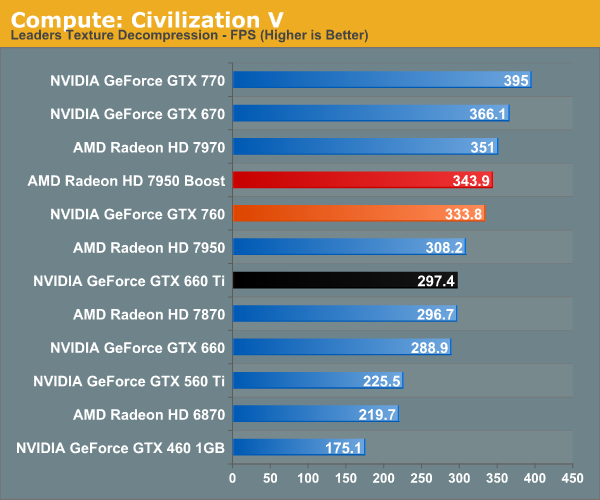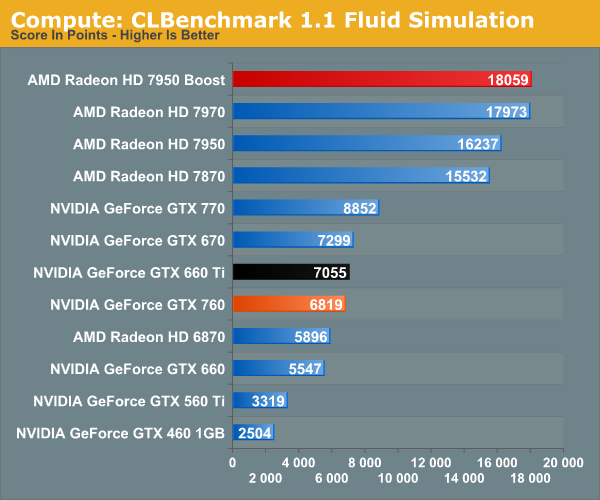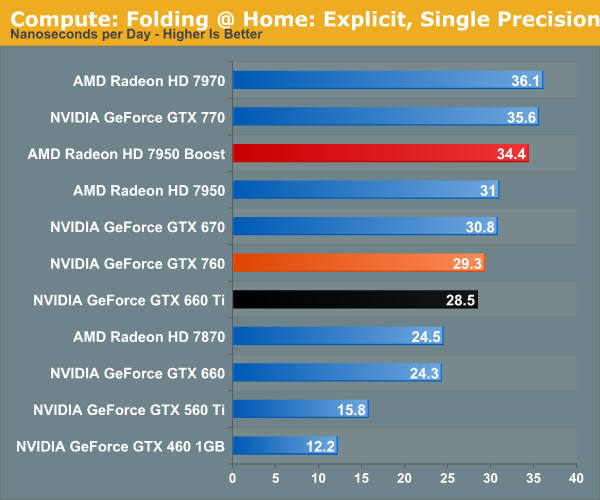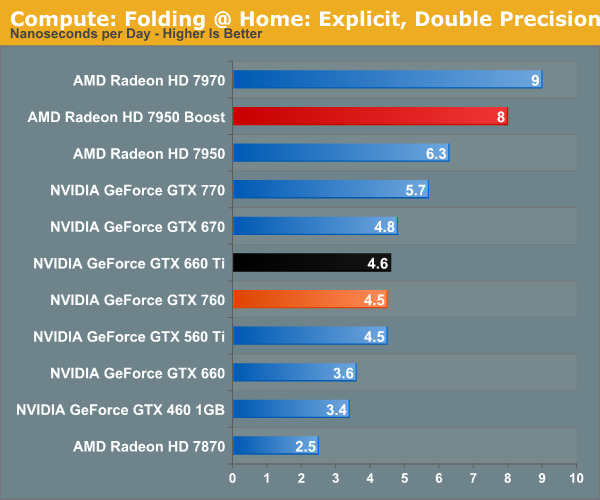NVIDIA GeForce GTX 760 Review: The New Enthusiast Kepler
by Ryan Smith on June 25, 2013 9:00 AM ESTCompute
Jumping into compute, we aren’t expecting too much here. Outside of DirectCompute GK104 is generally a poor compute GPU, and the loss of an SMX relative to the GTX 660 Ti isn’t doing the GTX 760 any favors here. By all appearances the GTX 760 is even more of a pure gaming card than the GTX 660 Ti was.
As always we'll start with our DirectCompute game example, Civilization V, which uses DirectCompute to decompress textures on the fly. Civ V includes a sub-benchmark that exclusively tests the speed of their texture decompression algorithm by repeatedly decompressing the textures required for one of the game’s leader scenes. While DirectCompute is used in many games, this is one of the only games with a benchmark that can isolate the use of DirectCompute and its resulting performance.

Civilization V once more validates that NVIDIA’s DirectCompute performance is generally up to snuff in this case. The fact that the GTX 760 is ahead of the GTX 660 Ti by any degree took us by surprise at first, but we’re likely looking at a scenario where the wider memory bus and/or larger L2 cache of GTX 760 offset some of the general compute gap.
Our next benchmark is LuxMark2.0, the official benchmark of SmallLuxGPU 2.0. SmallLuxGPU is an OpenCL accelerated ray tracer that is part of the larger LuxRender suite. Ray tracing has become a stronghold for GPUs in recent years as ray tracing maps well to GPU pipelines, allowing artists to render scenes much more quickly than with CPUs alone.

Luxmark is entirely about compute performance, and as a result this is an exceptionally poor showing for the GTX 760, with the GTX 660 Ti having no trouble besting it.
Our 3rd benchmark set comes from CLBenchmark 1.1. CLBenchmark contains a number of subtests; we’re focusing on the most practical of them, the computer vision test and the fluid simulation test. The former being a useful proxy for computer imaging tasks where systems are required to parse images and identify features (e.g. humans), while fluid simulations are common in professional graphics work and games alike.


Breaking down our CLBenchmark results, the computer vision test has frequently favored raw clockspeed over total shader throughput, which gives the GTX 760 an interesting advantage here. It’s capable of easily leaving the GTX 660 Ti in the dust and even edge out the GTX 670. Of course this is still less than 2/3rds the performance of even the slowest AMD GCN card, reflecting AMD’s superior computer performance.
The fluid simulation is especially brutal in that regard. Once again shifting back to an almost complete reliance on shader throughput, GTX 760 slightly trails GTX 660 Ti, never mind the nearly three-fold difference between it and the 7950B.
Moving on, our 4th compute benchmark is FAHBench, the official Folding @ Home benchmark. Folding @ Home is the popular Stanford-backed research and distributed computing initiative that has work distributed to millions of volunteer computers over the internet, each of which is responsible for a tiny slice of a protein folding simulation. FAHBench can test both single precision and double precision floating point performance, with single precision being the most useful metric for most consumer cards due to their low double precision performance. Each precision has two modes, explicit and implicit, the difference being whether water atoms are included in the simulation, which adds quite a bit of work and overhead. This is another OpenCL test, as Folding @ Home has moved exclusively to OpenCL this year with FAHCore 17.


Unlike some of our other compute benchmarks, the GTX 760 doesn’t fare too poorly here when it comes to single precision. However it’s still notably behind the 7950B in this case. And with double precision it’s no contest.
Wrapping things up, our final compute benchmark is an in-house project developed by our very own Dr. Ian Cutress. SystemCompute is our first C++ AMP benchmark, utilizing Microsoft’s simple C++ extensions to allow the easy use of GPU computing in C++ programs. SystemCompute in turn is a collection of benchmarks for several different fundamental compute algorithms, as described in this previous article, with the final score represented in points. DirectCompute is the compute backend for C++ AMP on Windows, so this forms our other DirectCompute test.

As another compute throughput bound benchmark, the GTX 760 is essentially tied with the GTX 660 Ti. This benchmark is somewhat memory bandwidth sensitive, which is why the GTX 760 doesn’t outright lose to the GTX 660 Ti here.










110 Comments
View All Comments
Spunjji - Tuesday, June 25, 2013 - link
Why would a faster card need to be cheaper? Shoo, shoo! Back under your bridge.UltraTech79 - Tuesday, July 2, 2013 - link
???vailr - Tuesday, June 25, 2013 - link
Will there be a "Small Form Factor" version, similar to:http://www.newegg.com/Product/Product.aspx?Item=N8...
chizow - Tuesday, June 25, 2013 - link
Sad day in the GPU industry when a part that's ~75% of the *SECOND* tier ASIC and sells for $250 can be considered "Enthusiast".It looks like Nvidia's marketing push to carve out ultra and uber enthusiast markets has worked, on the media anyways. Parts in this range used to be referred to as mainstream/midrange performance or gamer cards in the past, never once referred to as "Enthusiast".
Honestly if this $250 part is "Enthusiast" what are the $400 770, the $650 780, the $1000 Titan??? I guess we need to cough up $250 more for each Uber we place in front of Enthusiast; maybe at some point we just find new words and categories when one has been devalued and depreciated to the point it no longer holds any meaning.
Aside from the rant, the part's price and performance looks good. It's pretty clear at this point Kepler benefits more right now from the ROPs and bandwidth than SP and TMU. May change with future shader intensive titles, but the 760 pretty much confirms the 660Ti (and virtually any 30%+ bandwidth-neutered parts) was a big mistake.
thesavvymage - Tuesday, June 25, 2013 - link
who cares what ASIC it comes from, its irrelevant. Its a $250 gpu that performs as well or better than more expensive cards. Thats not mainstream, its enthusiast. Everything above it is enthusiast. The absolutely biggest amount of gpu sales come from those south of $200, so thats what most people consider mainstream.chizow - Wednesday, June 26, 2013 - link
People who don't enjoy getting less for the same price care what ASIC it comes from. I guess you don't mind getting smaller and smaller burgers, or less and less ounces in the food you buy at the grocery each year?There is nothing enthusiast about this product, it's mainstream performance in the same price and market bracket that litters all of Nvidia's previous marketing slides in this $200-$300 range. Was the 8800GT an enthusiast card? No. Was the 560Ti an enthusiast card? No. Yet they both satisfy the criteria you set forth.
teiglin - Tuesday, June 25, 2013 - link
I was just thinking about this after reading the review over at Tom's (they refer to the 760 as mainstream). It's an interesting sociological exercise, how different people view the term enthusiast. Given the massive stratification at the high end--I mean, Titan, ffs--what is the cutoff for being an "enthusiast" card? Why even bother with hyperbolic modifiers when nobody who spends even $400 on a GPU would do so without knowing the difference between a 770, a 780, and a Titan, not to mention the 7970 [GHz edition], 7950 [Boost], etc.?Personally, I'm inclined to agree with Ryan here. This is still a heckuva lot more graphics horsepower than, say, certain yet-to-be-released consoles, which I would argue define a "mainstream" baseline. Though if you're just commenting on how much the lowest common denominator in graphics performance has fallen, then that may be a sad day for the GPU industry, but it's a good day for consumers, who are able to get way more GPU for much less money than a couple years ago.
chizow - Wednesday, June 26, 2013 - link
Sorry but getting "way more GPU for much less money than a couple years ago" is just progress and should be expected.The context for how different people view the term enthusiast should be consistent, based on historical price and performance categories as well as physical and marketing segmentation factors. All of which indicate this is NOT an enthusiast part. Nvidia has clearly defined this in the past, and the enthusiast market did not start until $350+.
Some may say, "who cares", I guess people who actually shop in this $350+ market care, because calling a $250 part sets a terrible precedent, same as selling a tier-2 midrange ASIC like GK104 at $500 sets a terrible precedent. Why? Because if Nvidia is selling their 2nd fastest ASIC at "Enthusiast" price ranges starting at $250 all the way to $500, that gives them license to sell their actual Enthusiast parts at much more than $500.
Is it any surprise that we now have $650 GTX 780 and $1000 GTX Titan and GTX 690? Of course not. Why? Because people are doing cartwheels in the streets over the privilege of buying a stripped down, overclocked 2nd-tier ASIC for $250, because it's the new enthusiast part!
UltraTech79 - Tuesday, July 2, 2013 - link
I put the $1000 Tital as 'Rich retard soon parts with his money.' Also, shut the fuck up elitest dumbfuck. Anyone willing to spend $200+ on a GPU is an enthusiast and is looking for more than just enough.chizow - Friday, July 5, 2013 - link
Yes just like the guy who rices up his Civic is now driving a "luxury sports car". Just another idiot that doesn't understand I'm actually advocating against elitest pricing and marketing brackets, move along if you don't understand the concepts and repercussions.